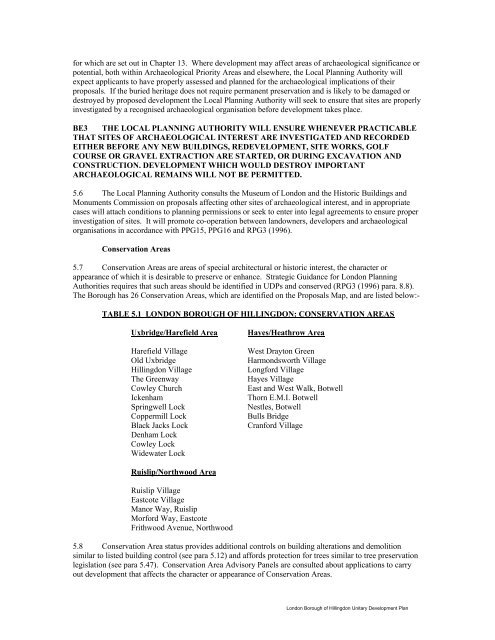HILLINGDON UNITARY DEVELOPMENT PLAN - London Borough ...
HILLINGDON UNITARY DEVELOPMENT PLAN - London Borough ...
HILLINGDON UNITARY DEVELOPMENT PLAN - London Borough ...
You also want an ePaper? Increase the reach of your titles
YUMPU automatically turns print PDFs into web optimized ePapers that Google loves.
for which are set out in Chapter 13. Where development may affect areas of archaeological significance or<br />
potential, both within Archaeological Priority Areas and elsewhere, the Local Planning Authority will<br />
expect applicants to have properly assessed and planned for the archaeological implications of their<br />
proposals. If the buried heritage does not require permanent preservation and is likely to be damaged or<br />
destroyed by proposed development the Local Planning Authority will seek to ensure that sites are properly<br />
investigated by a recognised archaeological organisation before development takes place.<br />
BE3 THE LOCAL <strong>PLAN</strong>NING AUTHORITY WILL ENSURE WHENEVER PRACTICABLE<br />
THAT SITES OF ARCHAEOLOGICAL INTEREST ARE INVESTIGATED AND RECORDED<br />
EITHER BEFORE ANY NEW BUILDINGS, RE<strong>DEVELOPMENT</strong>, SITE WORKS, GOLF<br />
COURSE OR GRAVEL EXTRACTION ARE STARTED, OR DURING EXCAVATION AND<br />
CONSTRUCTION. <strong>DEVELOPMENT</strong> WHICH WOULD DESTROY IMPORTANT<br />
ARCHAEOLOGICAL REMAINS WILL NOT BE PERMITTED.<br />
5.6 The Local Planning Authority consults the Museum of <strong>London</strong> and the Historic Buildings and<br />
Monuments Commission on proposals affecting other sites of archaeological interest, and in appropriate<br />
cases will attach conditions to planning permissions or seek to enter into legal agreements to ensure proper<br />
investigation of sites. It will promote co-operation between landowners, developers and archaeological<br />
organisations in accordance with PPG15, PPG16 and RPG3 (1996).<br />
Conservation Areas<br />
5.7 Conservation Areas are areas of special architectural or historic interest, the character or<br />
appearance of which it is desirable to preserve or enhance. Strategic Guidance for <strong>London</strong> Planning<br />
Authorities requires that such areas should be identified in UDPs and conserved (RPG3 (1996) para. 8.8).<br />
The <strong>Borough</strong> has 26 Conservation Areas, which are identified on the Proposals Map, and are listed below:-<br />
TABLE 5.1 LONDON BOROUGH OF <strong>HILLINGDON</strong>: CONSERVATION AREAS<br />
Uxbridge/Harefield Area<br />
Harefield Village<br />
Old Uxbridge<br />
Hillingdon Village<br />
The Greenway<br />
Cowley Church<br />
Ickenham<br />
Springwell Lock<br />
Coppermill Lock<br />
Black Jacks Lock<br />
Denham Lock<br />
Cowley Lock<br />
Widewater Lock<br />
Hayes/Heathrow Area<br />
West Drayton Green<br />
Harmondsworth Village<br />
Longford Village<br />
Hayes Village<br />
East and West Walk, Botwell<br />
Thorn E.M.I. Botwell<br />
Nestles, Botwell<br />
Bulls Bridge<br />
Cranford Village<br />
Ruislip/Northwood Area<br />
Ruislip Village<br />
Eastcote Village<br />
Manor Way, Ruislip<br />
Morford Way, Eastcote<br />
Frithwood Avenue, Northwood<br />
5.8 Conservation Area status provides additional controls on building alterations and demolition<br />
similar to listed building control (see para 5.12) and affords protection for trees similar to tree preservation<br />
legislation (see para 5.47). Conservation Area Advisory Panels are consulted about applications to carry<br />
out development that affects the character or appearance of Conservation Areas.<br />
<strong>London</strong> <strong>Borough</strong> of Hillingdon Unitary Development Plan
















